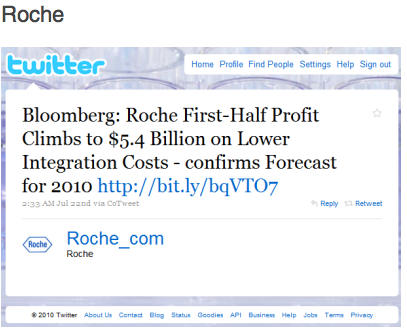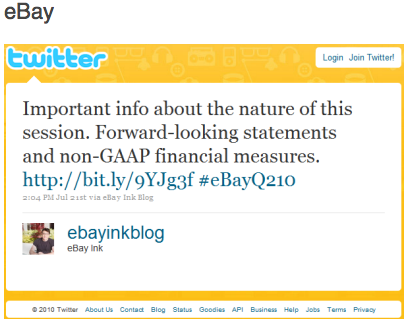That’s an issue many have mixed feelings about. I, for one, think it’s a great way to relay investor information to the modern, web-loving world in a timely manner. Along with posting earnings on their websites, companies (well, some of them) are using Twitter to announce, among other news, performance numbers.
The microblogging site has seen a flood of earnings tweets for the second quarter of 2010. Some, however, are doing this better than others. IR Web Report compiled a list of 10 public companies that are using Twitter as an investor relations tool — with comments on what they’re doing right and wrong. Here’s a snapshot:

URL: https://twitter.com/PGNewsUS
Followers: 5,166
Apps used: Twitterfeed, CoTweet, TweetDeck
# of Earnings Tweets: 14
# of Clicks from Tweets: 75
Comments: The tweets are coming from P&G’s media relations team, so strictly speaking their activity doesn’t qualify as IR. Except it does because investors don’t discriminate. The tweets are plain vanilla, no hashtags or tickers. There’s a bit of “spin,” but mostly the tweets are informative. Still, the company’s IR department should have it’s own account. It’s hard to find the signal when sales numbers are mixed in with soap suds. The low click-thrus suggest that earnings tweets on this account don’t resonate.

URL: https://twitter.com/Roche_com
Followers: 4,586
Apps used: CoTweet
# of Earnings Tweets: 21
Clicks generated: 182
Comments: Only company where I had to use a calculator to add up all the various clicks to their site! Probably the best experience from a follower’s perspective. By not live tweeting the earnings call, they don’t overwhelm their followers and drive traffic to the webcast. But the greatest value comes from them referring followers to the media’s rolling coverage of the results throughout the day. From start to finish, it’s a well-managed process that is a valuable enhancement to what the company already provides on its website. The one to emulate.

URL: http://twitter.com/ebayinkblog
Followers: 4,638
Apps used: Blog, Seesmic
# of Earnings Tweets: 63
Clicks generated: 169
Comments: The original earnings live-tweeter, eBay continues to be a standard setter. It’s one of the few to incorporate StockTwits into its distribution. Its disclaimer at the start of earnings call live-tweeting sessions, and use of an unique hashtag for each call, are best practices. But too many tweets for my liking, but no one else complains so I’m wrong. Could say more but Richard’s already gotten a lot of ink here. He’s posted a good piece about his set-up and process.
Sure, tweeting financial performance data may be good for these large, blue-chip companies, but the same may not be true for smaller, less visible firms. According to research from the University of Michigan, small and micro-cap companies that participate in greater tweeting “during news event windows is associated with lower bid-ask spreads and greater depths.” Meaning, essentially, a lower stock price. Not good.
Tweeting earnings can have other harsh side-effects. If a company announces earnings news on other sites (such as their corporate website) first, then turns to Twitter (sometimes hours later), it is a slap in the face to the company’s loyal followers. Here are some examples of delayed earnings tweets (courtesy of IR Web Report):
- A gold company listed both in the US and Canada issued a results release at 8:00am ET but only tweeted the news at 6:45pm ET –- a delay of 10 hours and 45 minutes.
- A uniform company released earnings via a PR wire at 4:15pm ET and tweeted the same information 77 minutes later at 5:32pm ET.
- A technology company issued its release at 4:15pm ET and only tweeted it at 4:43pm ET, a 28-minute period during which more than 150,000 shares were traded.
- A health care solutions company released earnings at 4:00pm ET but didn’t mention the results on Twitter until announcing at 4:35pm ET that its conference call had started. Eventually, the results release showed up, but almost 8 hours after the fact at 11:53pm ET.
- A networking company released earnings via a PR wire at 4:05pm ET but tweeted it only at 4:31pm ET – a 26-minute delay during which more than 100,000 shares changed hands.
- A hard disk drive maker that released its results at 4:01pm ET but tweeted them only 24 minutes later at 4:25pm ET – a delay which saw more than 200,000 shares traded.
To investors, these are serious lapses from major corporations’ IR departments. If a company that is active on Twitter cannot manage to update its followers and investors in 140 characters or less on important information in a timely manner, how can it expect to keep such a following?
With more and more companies waking up to the power of social media, more and more sloppiness in the the Twitter and Facebook realm is visible. For companies large and small, to be complacent with such technology is to dig your own grave.





